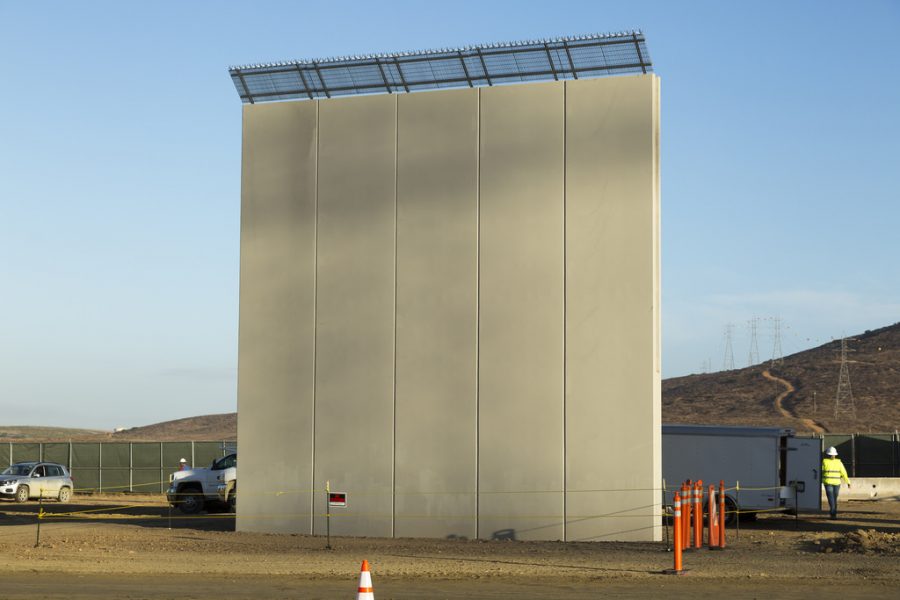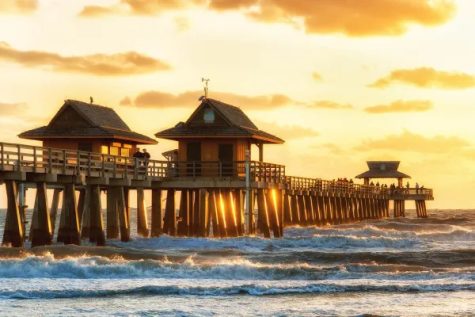Border wall divides Americans
Debate continues on pros and cons of building a wall across the Mexican and U.S. border
Possible prototypes for the border wall shown in development near the US/Mexico border.
A wall is not the answer by Anna Forst
Congress under the Trump Administration has argued for the past two years about the implementation of an approximately 18-foot wall, spanning 100 miles across the Mexican-American border to “fix” immigration control. This possibility of “the wall” affects millions of migrants hoping to flee to the promised shelter of the U.S., as well as stir fear among current immigrants living in the country, illegally or not.
While the wall may reinforce their ideas of necessary security, it involves the physical rejection of people at the border. Advocates seem to overlook the physical implications of the wall that not only prohibits border crossing, but prevents innocent people from receiving sanctity in the land of the free and the home of the brave.
The Pew Research Center found that over 1 million immigrants arrive in the U.S. each year. The massive presence of immigrants not only changes the scale of majority to minority, but they enrich our culture and our ways of living. In any city, one can walk down the street and find a range of cultural imprints; from Cuban diners to Indian marts, immigrants bring unique ideas to share.
If the U.S. were to build a wall along the entirety of the Southern border and enforce a hard line on these desperate migrants from entering, they would lose a vital chance to escape the treacherous living conditions they were born into. The U.S. is applauded for its motto of freedom, ideals of peace and equality, yet the President and his administration continue to violate the very building blocks of the nation.
Besides the issue of morality, there is a prominent cost issue in this majority-Republican championed wall.
Fox News broke down the possible costs of the border wall into the materials, labor and land acquisition, reporting a supposed cost of approximately $8.7 billion in concrete, $3.6 billion in steel and $12.3 billion in labor. Approximately 60 percent of the border is privately owned land and would cost the government $200 million to acquire this land by compensation.
America needs an efficient solution to the problem of immigration control.
One popular idea is the concept of increased aid at the border or at ports of entry. If border security increased their attention to immigrants entering receiving fair trials over the immediate impulse to turn them away, more people would be processed and become legal citizens.
There also must be reform to the legal immigration process as a whole. Seeking asylum is the first step, however, many immigrants aren’t granted asylum on claims that entering the country on accounts of fear for one’s life isn’t a credible reason according to the U.S. Justice System. There is also a high stakes interview to determine the credibility of any claim; if one passes, a long process of hearings begins. If they fail, they are deported on sight.
The application process for citizenship is equally cumbersome. In theory, the process appears simple, but the reality is the opposite. One must already hold a green card and be a legal alien in the U.S., pay fees to submit applications and schedule an interview. This interview scheduling spans months, and once the date is secure, the persons at stake must be fluent and efficient in their understanding of U.S. history and politics. If the process to become a citizen was more accessible to those fleeing their home countries, then there wouldn’t be a need for a wall to keep them out.
Build the wall, crime will fall by Dylan Jonas
The question over a potential border wall to control immigration has millions of people divided. One side sees the wall as anti-immigrant, while the other side as pro-security.
On one side stand the people who argue the wall would serve as a positive addition to this country. They point to other countries, such as Israel, Hungary, and Spain with similar methods of border defense and their record low numbers of illegal immigrants. Supporters of the wall simply want more security for the nation’s borders, not a full halt to immigration. Immigration brings hard-working people who will boost the economy and do their fair share of work.
However, illegal immigration becomes an issue when people live in the U.S. without paying taxes and gain access to emergency services and other benefits of Americans in times of need. Among those wanting to enter America for a better life, drug traffickers also get mixed in, seeking to profit off of the endangerment of people with addictive hard drugs. Yet, when those in power propose increased spending on border security in the form of a wall in America, it is almost instantly shot down. Supporters of the wall believe illegal immigration is the problem, not immigration as a whole.”
A perfect example would be a rigorous test of one’s ability to work in America to ensure the capabilities of the immigrants allowed into the country. Illegal immigration cheats those who legally and rightfully come to the United States.
Moreover, companies hiring undocumented workers to lower their labor costs contribute to the problem. If undocumented workers were to be removed from the country, the companies would lose money. This would decrease profits and in turn, anger from other workers who would potentially lose jobs so the company can recoup their losses.
While there are clear benefits to the wall, the implementation will present its own problems. Immigrants do not enter the country solely by crossing the border. Many cross the borders into ports and airports and overstay their visas. Instead of a wall, the border as a whole should be secured. This would include more militarized points of entry and tighter security around ports, airports and road entrances with more in-depth inspections and a larger number of immigration agents in these areas.
If the U.S. truly wants to battle illegal immigration, the path to legal citizenship must be revised. The U.S. has some of the toughest immigration laws in the world, yet illegal immigration continues to pose a constant threat.
People resort to illegal immigration in order to get past a rigorous yet highly inefficient system that can take at times years to accept a single person as a legal resident.
Overall, a border wall is a necessary protection that would protect Americans, yet a wall is not the only solution. Security must be tightened at all American borders to ensure the safety of legal residents, enforce rules and decrease attempted cheats to the system.









